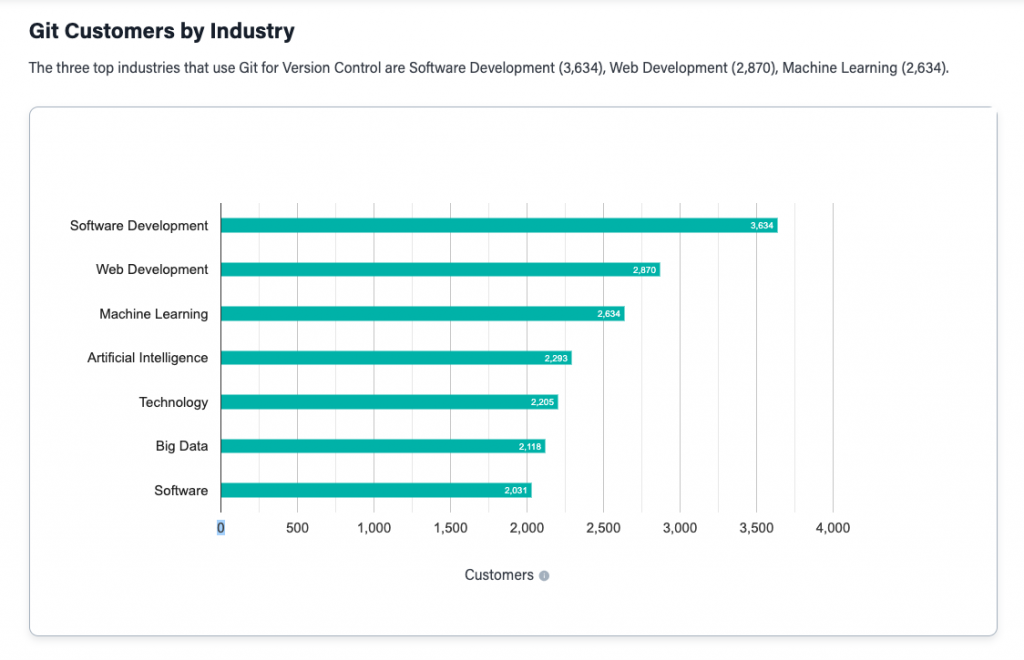Version control systems (VCS), such as Git and Mercurial, are indeed indispensable tools for web development. They provide a structured and efficient way to manage and track changes in your codebase. This is particularly crucial in the dynamic world of web development, where code evolves rapidly. With a VCS, you can ensure that every modification is documented, making it easier to understand and collaborate on projects.
Collaboration is a cornerstone of modern web development, and VCS plays a vital role in this process. It enables multiple developers to work on the same codebase simultaneously, even if they are geographically dispersed. Through branches and pull requests, developers can propose, review, and integrate changes seamlessly. This collaborative approach fosters team cohesion and productivity, as it streamlines communication and minimizes the risk of code conflicts.
VCS and Web Development Automation: A Statistical Look

Source: 6sense
- 87% of developers use VCS to automate some part of their web development workflow.
- The most popular version control system is Git, used by over 70% of teams.
- Subversion (SVN) is used by over 20% of teams, while Mercurial is used by less than 5%.
- 65% of developers use VCS to automate their code linting and testing.
- Version Control Systems Market size was valued at USD 663.10 Million in 2022 and is projected to reach USD 1,368.03 Million by 2030, growing at a CAGR of 9.3% from 2023 to 2030.
How to Automate your Web Development Workflow
Task runners
Task runners are tools that can be used to automate common tasks in your web development workflow. They can be used to run unit tests, minify and compress code, deploy your application to production, and more.
Some popular task runners include:
Grunt,Gulp and Webpack.
To use a task runner, you first need to install it and create a configuration file. The configuration file will specify the tasks that you want to automate and the order in which you want them to run.
Once you have created a configuration file, you can run your tasks by executing a command in your terminal. For example, to run all of your tasks using Grunt, you would execute the following command: grunt
You can also use task runners to create custom tasks. For example, you could create a task to minify and compress your code before deploying it to production.
Continuous integration
Continuous integration (CI) is a practice that automates the building and testing of your code every time you make a change. This can help you to catch bugs early and prevent them from making it into production.
Some popular CI tools include:
Jenkins
CircleCI
Travis CI
To use a CI tool, you first need to create an account and configure it to build and test your code. Once you have configured your CI tool, it will automatically build and test your code every time you push a change to your code repository.
CI tools can also be used to generate reports on the results of your builds and tests. This can help you to identify and fix problems with your code before deploying it to production.
Continuous delivery
Continuous delivery (CD) is a practice that automates the deployment of your code to production every time it passes your CI tests. This can help you to release new features and updates to your users more quickly.
Some popular CD tools include:
Ansible
Chef
Capistrano
To use a CD tool, you first need to configure it to deploy your code to production. Once you have configured your CD tool, it will automatically deploy your code to production every time your CI tests pass.
CD tools can also be used to roll back deployments if they fail. This can help you to minimize the impact of deployment failures on your users.
Combining task runners, CI, and CD
You can combine task runners, CI, and CD to create a fully automated web development workflow.
For example, you could use a task runner to minify and compress your code before pushing it to your code repository. You could then use a CI tool to build and test your code every time you push a change to your code repository. Finally, you could use a CD tool to deploy your code to production every time your CI tests pass.
This would allow you to release new features and updates to your users with minimal manual effort.
Benefits of VCS
Increased efficiency
Automating repetitive tasks can free up your time so you can focus on more important work, such as developing new features and fixing bugs. For example, you can use a task runner to automate the process of minifying, linting, and testing your code. This can save you a lot of time, especially if you have a large project with a lot of code.
Reduced errors
Automated tasks are less likely to make mistakes than humans, which can lead to a more reliable and high-quality product. For example, you can use a continuous integration (CI) tool to automatically build and test your code every time you make a change. This can help you to catch bugs early and prevent them from making it into production.
Improved collaboration
Automation can help teams to collaborate more effectively by making it easier to share code and track changes. For example, you can use a version control system (VCS) such as Git to store and manage your code. This allows team members to easily share code and track changes, which can help to avoid conflicts and improve communication.
Faster releases
Automated deployment can help you to release new features and updates more quickly, which can keep your users happy and engaged. For example, you can use a continuous delivery (CD) tool to automatically deploy your code to production every time you pass your CI tests. This can help you to get new features and updates into the hands of your users as quickly as possible.
Reduced costs
Automating tasks can save you money on labor costs and the cost of fixing errors. For example, if you automate the process of deploying your code to production, you don’t have to pay someone to do it manually. Additionally, if you automate your testing process, you can catch bugs early and prevent them from making it into production, which can save you money on the cost of fixing them.
Real-World Examples of How VCS Can Improve Efficiency and Productivity
Case Study 1: Netflix
Netflix uses Git to manage its codebase, and it has developed a number of custom tools to automate tasks such as code review, testing, and deployment. One of the key benefits of Netflix’s automated web development workflow is that it allows the company to release new features and updates to its users quickly and frequently.
For example, Netflix uses a tool called “Chaos Monkey” to randomly terminate servers in its production environment. This helps to ensure that Netflix’s applications can withstand unexpected failures. Netflix also uses a tool called “Spinnaker” to automate the deployment of new code to production. Spinnaker can deploy code to multiple environments, such as staging and production, with a single click.
Case Study 2: Google
Google uses Git to manage its codebase, and it has developed a number of internal tools to automate tasks such as code review, testing, and deployment. One of the key benefits of Google’s automated web development workflow is that it allows the company to maintain a high level of code quality.
Google has a very strict code review process, and its automated tools help to ensure that all code changes are reviewed and tested before they are deployed to production. For example, Google uses a tool called “Piper” to automate the code review process. Piper checks for common code style errors and suggests improvements. It also ensures that all code changes are covered by unit tests.
Case Study 3: Airbnb
Airbnb uses VCS to automate its web development workflow, and it has developed a number of custom tools to automate tasks such as code review, testing, and deployment. One of the key benefits of Airbnb’s automated web development workflow is that it allows the company to scale its development team quickly.
Airbnb has a large and distributed development team, and its automated tools help to ensure that all team members are working on the same codebase and that all code changes are reviewed and tested before they are deployed to production. For example, Airbnb uses a tool called “Semaphore” to automate the testing process. Semaphore runs a suite of unit tests, integration tests, and end-to-end tests on all code changes before they are deployed to production.
In a Nutshell
Automating your web development workflow can save you time and money, and help you to release higher-quality products more quickly. By using VCS, task runners, CI, and CD, you can create a fully automated workflow that will take care of all of the repetitive tasks for you. This will free you up to focus on more important tasks, such as developing new features and fixing bugs.
If you are looking for a team of experts to help you automate your web development workflow, then look no further than GeekyAnts. GeekyAnts is a leading provider of web development and software development services. We have a team of experienced and skilled developers who can help you to automate your workflow and improve the efficiency, accuracy, and speed of your development process.
Contact us today to learn more about how we can help you automate your web development workflow.


















